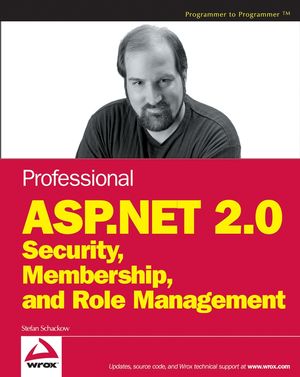Professional ASP.NET 2.0 Security, Membership, and Role ManagementISBN: 978-0-7645-9698-8
Paperback
648 pages
January 2006
 This title is out-of-print and not currently available for purchase from this site.
|
Do you think you've discovered an error in this book? Please check the list of errata below to see if we've already addressed the error. If not, please submit the error via our Errata Form. We will attempt to verify your error; if you're right, we will post a correction below.
| Chapter | Page | Details | Date | Print Run |
|---|---|---|---|---|
| 114 | Addition to text "ReflectionPermission" section, 2nd paragraph, add the following sentence: You can still use reflection to access methods, members, etc... that would normally be available to public callers. For example, even in Medium trust you can still use reflection to invoke the public methods on a Membership provider. |
1/31/06 | ||
| 137 | Error in Text 3rd paragraph, 1st sentence: Delete the phrase ", and in fact there is no way to turn this behavior off for no-compile pages." |
1/31/06 | ||
| 138 | Error in Text 1st paragraph, 1st sentence The phrase "then for compiled pages ASP.NET 2.0" should be "then ASP.NET 2.0" |
1/31/06 | ||
| 231 | Error in Text last paragraph, 1st sentence Due to a bug in the shipping version of ASP.NET 2.0, forms authentication uses the wrong cookie path when it issues a new cookie based on information from a cross-application redirect. As a result, this sample will not work with cookie paths other than "/". The next section on "Cookie-based SSO Lite" describes the problem on page 237, in the fourth paragraph. The code in this section also shows how to workaround the problem. |
1/31/06 | ||
| 237 | Error in Text second to last paragraph Add sentences at the end of the paragraph saying: This restriction applies specifically to ASP.NET's automatic generation of the ReturnUrl variable. As an alternative to the CustomReturnUrl variable, you could take control of the ReturnUrl variable and programmatically set it to a fully qualified address. |
1/31/06 | ||
| 9 | 332 | Error in Code Chapter 9, Page 332, top of page, Item #4 missing dot between Configuration and Providers: Code reads: System.Web.ConfigurationProvidersHelper Should read: System.Web.Configuration.ProvidersHelper |
07/20/2006 | |
| 437 | Error in Text fourth paragraph (the last one before the section "Enforcing Custom Password Strength Rules") 42 should be 38 in 3 places in this paragraph |
1/31/06 | ||
| 437 | Error in Text fourth paragraph (the last one before the section "Enforcing Custom Password Strength Rules") end of 5th line: 40+- should be 39+ From testing this some more with more complex passwords, 38 characters turned out to be the effective upper limit. |
1/31/06 |



